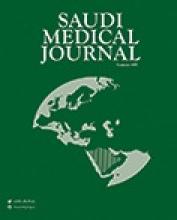SYSTEMATIC REVIEW
Efficacy and adverse events of pirfenidone in treating idiopathic pulmonary fibrosis
Ren et al conclude that pirfenidone could reduce disease progression as assessed by the decline in forced vital capacity (FVC) in idiopathic pulmonary fibrosis (IPF). Pirfenidone represents a suitable treatment option for patients with IPF. The meta-analysis revealed that pirfenidone reduced the risk of decline in FVC% ≥10% from baseline (relative risk: 0.62; 95% CI: 0.51-0.76, p<0.001). The pirfenidone group had a significantly higher rate of adverse events compared with the placebo group. Pirfenidone did not reduce mortality from any cause significantly (odds ratio: 0.63; 95% CI: 0.36-1.09).
Literature search and selection, RCT - randomized controlled trials, IPF - idiopathic pulmonary fibrosis
see page 889
ORIGINAL ARTICLES
Celiac disease in Saudi children. Evaluation of clinical features and diagnosis
Saeed et al investigated the clinical presentations and diagnosis including serological tests and histopathological findings in children with celiac disease. A total of 59 children had confirmed celiac disease. Thirty (50.8%) were male. Median age was 8 years (range 1 to 16 years). The mean duration of symptoms before diagnosis was 2.3 (±1.5) years. Classical disease was present only in 30.5%, whereas 69.5% had either non-classical presentations or belonged to high risk groups for celiac disease such as those with type-1 diabetes, autoimmune thyroiditis, Down syndrome and siblings. Failure to thrive was the most common presentation followed by short stature, abdominal pain and chronic diarrhea.
The frequency distribution of the causes of burns in patients demographic characteristics of patients with celiac disease (N=59)
see page 895
Acute coronary syndrome risk prediction of rapid emergency medicine scoring system in acute chest pain. An observational study of patients presenting with chest pain in the emergency department in Central Saudi Arabia
Mehmood et al assess the diagnostic validity of the rapid emergency medical score (REMS) for the risk stratification of acute coronary syndrome (ACS) from non-cardiogenic chest pain. In total, 176 (70.4%) of patients were men with a mean age of 49±8.5 years. The mean REM score of the patients was 9.3±4.5, and a sensitivity of 81.6%, specificity of 90.05%, positive predictive value of 66.67%, and a negative predictive value of 95.26% were obtained. The authors conclude that rapid emergency medical score is a simple and fairly valid tool that may be used for diagnosis of ACS with limited resources in emergency medicine.
see page 900
Association of fine particulate air pollution with cardiopulmonary morbidity in Western Coast of Saudi Arabia
Nayebare et al assess cardiopulmonary morbidity associated with daily exposures to PM2.5 in Western Coast of Saudi Arabia. They monitored 24-h PM2.5 and its constituents including black carbon (BC), particulate sulfate (p-SO42–), nitrate (p-NO3–), ammonium (p-NH4+) and trace elements (TEs). The p-NH4+ increased CVD risk by up to 20.3% (p=0.033) in males; and RD by 10.7% (p=0.014) in females and 8% (p=0.031) in males. No statistically significant association was observed for p-NO3– and TEs exposure.
Bar graphs showing the top diseases by age-groups in the emergency room (ER) visits for a) cardiovascular (CVD) and b) respiratory diseases (RD) during the study period
see page 905
- Copyright: © Saudi Medical Journal
This is an open-access article distributed under the terms of the Creative Commons Attribution-Noncommercial-Share Alike 3.0 Unported, which permits unrestricted use, distribution, and reproduction in any medium, provided the original work is properly cited.









